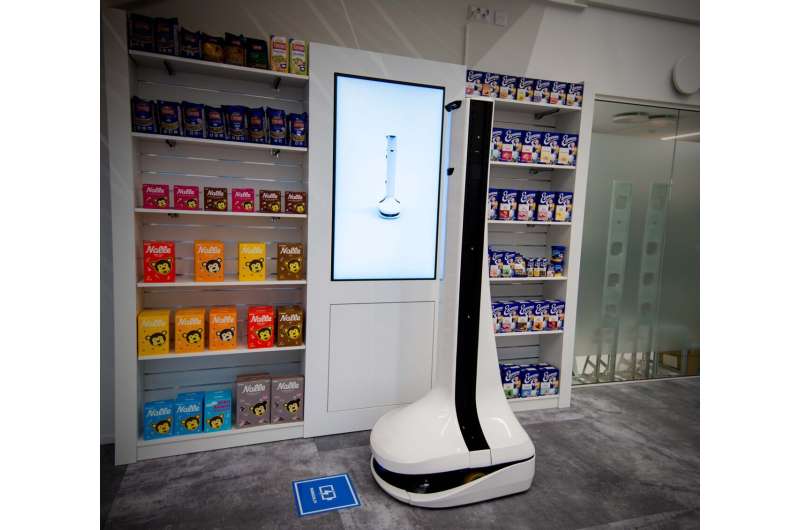New power transfer technology provides unprecedented freedom for wireless charging

A new power transfer technology makes it possible to conveniently charge devices without using any wires or plugs. Warehouse robots, kitchen appliances, and even phones or laptops can receive power anywhere over the charging area, and because the power transfer continues even while the device is in motion, this technology could one day power electric vehicles while they're on the go.
The basics of wireless power transfer have been in place for some time, but existing systems are not able to charge devices placed anywhere within a large area. Using a single large transmitter to cover the entire area leads to unwanted electromagnetic exposure and means that the power flow to individual devices cannot be controlled. If many small transmitters are used, the receiving devices must be in a known position, and the transmitter and receiver have to be precisely aligned. This means the system either has to use fixed charging locations or incorporate position sensors, communication protocols, and processing to track the location of each receiver.
Researchers at Aalto University have tackled these problems, developing a power transfer technology that works regardless of the position and orientation of the transmitter and receiver. The key idea is to arrange the transmitters in a grid with the current in neighboring transmitters running in opposite directions—for example, a clockwise loop in one transmitter and counter-clockwise loops in its neighbors.
This creates a chessboard-like grid of 'positive' and 'negative' transmitting coils with a magnetic flux between them. A receiver above the grid of transmitters captures the magnetic flux between positive and negative transmitters, which generates an electric current to charge the device.
"The beauty of our method is that it's very simple yet quite sophisticated," says Prasad Jayathurathnage, the postdoctoral researcher who led the project. "We don't need a high-end processor or lots of computations to make the transmitters intelligent. At the end of the day, it's all an electromagnetic system, and our approach was to figure out how we could detect the receiver's presence and position electromagnetically."
Because the presence of a receiver triggers the power transfer, the system can work without any positional tracking and communication between the receivers and transmitters. This also means that power is only transferred to the receiver, rather than the entire area being energized, and it makes it possible for several devices to be charged simultaneously.
Tiling transmitters together produces a charging area of the desired size and shape. A subset of the transmitters is then activated at lower power. "That's basically a search—the transmitters are listening for a receiver," explains Shamsul Al Mahmud, a doctoral student in the project. If power transfer to a receiver begins, the neighboring transmitters switch from being off into an alert mode, primed to transfer power if the receiver appears over them.
"With this configuration, we had almost constant efficiency and constant power received regardless of the receiver's position and orientation," says Ishtiaque Panhwar, a researcher involved in the project, and the power transfer continued smoothly even as the receiving device moved around.
The technology has been tested with commercial warehouse robots in cooperation with Finnish firm Solteq Robotics, and Jayathurathnage also leads the project Parkzia, a project funded by Business Finland. The project aims to commercialize this new technology for industry and transport. "Taking this technology out of the lab and seeing it work in the warehouse was an exciting moment for me personally," says Jayathurathnage. "I was finally bringing the product of ten years of research out of the lab."
More familiar applications can also improve our daily life. "Take kitchen appliances, for example," says Jayathurathnage. "At the moment, you need to put a rice cooker or a blender at a particular spot for it to get energy. But with our technology we can make the whole kitchen counter a source of power for appliances or even phones, but the electromagnetic field is only generated under the devices."
Although the technology is essentially ready for real-world applications, it still needs commercial packaging and certification. In the meantime, Jayathurathnage's team will continue to refine and improve this technology. One of their goals is to boost the power levels from about 1 kW to around 20 kW so that the technology could be used to charge electric vehicles. "There are pilot projects on electrifying roads across the world," says Jayathurathnage. "Electric vehicles are a really great application of this technology."
More information: Shamsul Al Mahmud et al, Large-Area Free-Positioning Wireless Power Transfer to Movable Receivers, IEEE Transactions on Industrial Electronics (2022). DOI: 10.1109/TIE.2022.3144591


















